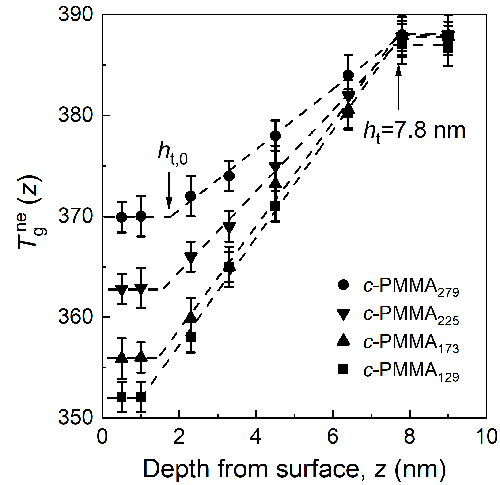纳米材料表面的分子状态是决定材料表面现象(润湿、摩擦、粘结等)和物理性能(力学、流变、结晶等)的关键因素。研究高分子表面分子的弛豫行为不仅有助于寻找调控纳米材料性能的新方法,还可为揭示玻璃化的本质这一凝聚态物理长期悬而未决的问题提供新的视角和证据。研究发现,玻璃态高分子表面存在一层运动能力增强的“活性层”;随着远离表面,分子运动能力逐渐减弱直至回到本体状态。然而,对于表面增强分子运动能力的传递距离和梯度分布规律的争论,以及实验上高空间分辨率测量表面附近局部分子弛豫时间(或玻璃化转变温度,Tg)的困难,阻碍了该领域的进一步发展。


Fig. 1. Experimental depth profiles Tgne(z) taken at the surface of various c-PMMA polymers. Dashed lines are the best fits to a linear gradient.

Fig. 2. Simulation results revealing intrinsic nonequilibrium effects on near-surface τ(z) of long-chain films. (A) Segmental relaxation time τ vs. inverse temperature for various segmental layers at different distances z/σ from the surface (σ is the length scale of the bead-spring potential). The dotted lines represent the low-temperature cutoff for inclusion of equilibrium relaxation time data and τ = tANN,max = 106. The curved lines show fits of the data to an established model for equilibrium dynamics. (B) Normalized alteration gradients of Tgeq and Tgne relative to bulk for systems with tANN,max = 105 and 106. The solid line shows a fit of Tgeq (z) to an exponential gradient form to the Tgeq data, while the dotted lines represent linear fits to the surface region.
论文链接:www.pnas.org/doi/10.1073/pnas.2406262121
课题组网页:https://www.chem.zstu.edu.cn/gfzclbjmsys.htm
